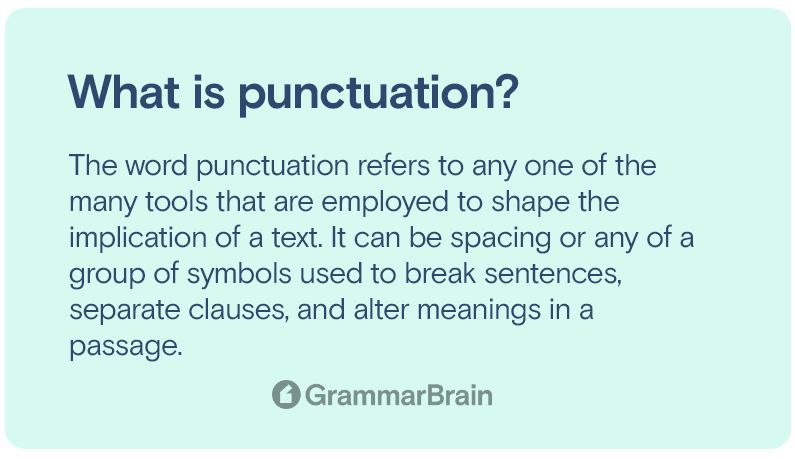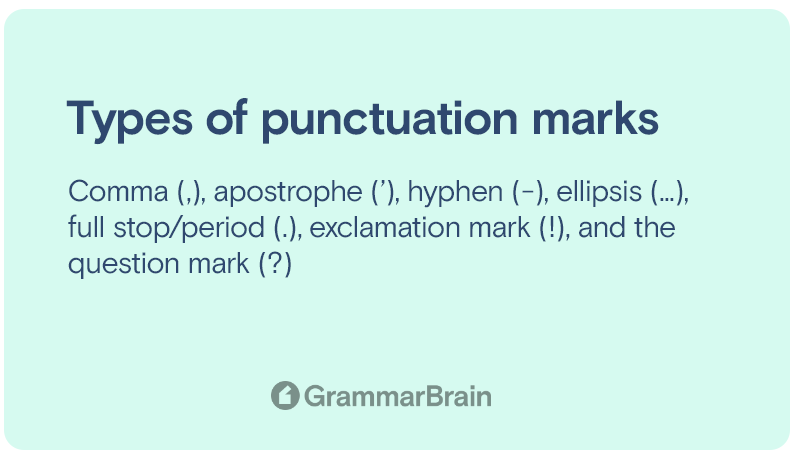What is punctuation? To achieve clarity, raw text is often demarcated into sentences, clauses, and phrases. And for this, various tools like spacing, certain signs known as punctuation marks, and a few typographical devices are employed. This is collectively called punctuation. Punctuation is also known by the term ‘Interpunction’.

What are the types of punctuation?
Some of the most widely used punctuation marks are:
1. Full stop a.k.a. period (.)
2. Question mark (?)
3. Comma (,)
4. Semicolon (;)
5. Exclamation mark (!)
6. Colon (:)
7. Apostrophe (‘)
8. Hyphen (–)
There are also other types like the dash (–), ellipses (…), parenthesis (()), etc.
1. Full Stop
This punctuation tool is denoted by the symbol of the dot ‘.’. Also called a ‘period’ in North American English, it is used to indicate the end of a statement or sentence.
Examples:
The Ford Explorer is a fine car.
Jane is a good girl.
Although this is the primary purpose of a full stop, it is also used for other purposes as follows. Full stops are used at the end of each initial in an abbreviation term.
Example: U.S.A. (United States of America)
Full stops are also used at the end of truncations and contractions in American English.
Examples:
Jan. (January), Prof. (Professor) – Truncations.
Mr. (Mister), Dr. (Doctor) – Contractions.
2. Question mark
It is denoted by the symbol ‘?’ and is used to mark a sentence as a question. It is also used to indicate doubt or uncertainty.
Examples:
In which continent is Italy located? – Question
Will it rain today? – Doubtful question
3. Comma
Denoted by the symbol ‘,’, it is used to denote a pause or interval in a sentence. It is also used to demarcate independent clauses. Commas are also used to split items in a list.
Examples:
Mary is a good girl, but she is a bit short-tempered at times.
I like red, blue, green, and purple colors.
4. Semicolon
Denoted by ‘;’, it is similar to a comma in creating a pause between two independent clauses. But it is only used when the pause has to be more prominent and when there is no coordinating conjunction like ‘and’ to join them.
Examples:
Britain was the leading sea power of the nineteenth century; she had numerous battleships in her service.
5. Exclamation mark
This punctuation mark (!) is used after an exclamation or interruption to add more emphasis to it.
Example: Hey, Look out!
6. Colon
This particular punctuation mark (:) is used to precede a list, an explanation, or a quote.
Examples:
There are four cardinal signs: Aries, Libra, Cancer, and Capricorn.
Oscar Wilde had once proclaimed: “Be yourself; everyone else is already taken.”
7. Apostrophe
This punctuation mark (‘) is used to express either a possession, omission of letters, or a plural form in certain cases.
Examples:
- That is Mary’s house. (Possession)
- He can’t do it without my help. (Omission: Here cannot is compressed to can’t)
- How many A’s have you got on your report card? (Plural for A)
8. Hyphen
This mark (–) (hyphen) is used to join different words that are either linked or have a combined meaning together. It is also used in line-wrapping, viz. splitting a word into two to facilitate continuation in the next line.
Examples:
Mother-in-law
Short-term
They were wandering in the woods without any food and water, but sud-
denly they heard a strange noise.

What does punctuation mean?
The word punctuation refers to any one of the many tools that are employed to shape the implication of a text. It can be spacing or any of a group of symbols used to break sentences, separate clauses, and alter meanings in a passage.
What is punctuation in a sentence?
Punctuation in a sentence is a special element that is used to create different points of emphasis and can even modify the overall meaning of a sentence or passage.
Example:
a) An adult Panda eats, shoots and leaves.
In the above sentence, the placement of the comma implies that an adult panda, will eat, fire a gun, and then leave. But the original intended meaning is that an adult panda’s diet consists of leaves and shoots.
Hence the sentence should be rewritten as:
b) An adult Panda eats shoots and leaves.
Thus the addition of a redundant comma in the first sentence can change the meaning of the sentence altogether.
Some more examples:
Come on! Let’s eat children– Wrong- Come on! Let’s eat, children – Correct
- Jim prefers yellow green and red.
- Jim prefers yellow, green and red.
What are the basic rules of punctuation?
The basic rules that must be followed while using punctuation marks are:
1) All punctuation marks used in a sentence should be parallel. For instance, if the main clause in a sentence is interrupted by a particular type of punctuation, the same type should be used at the end as well.
Example:
The bright girls – students of Dr. Mayer, visited the museum yesterday.– Wrong- The bright girls – students of Dr. Mayer – visited the museum yesterday. – Correct
- The bright girls, students of Dr. Mayer, visited the museum yesterday. – Correct
2) Semicolons can be used to join two independent clauses in the absence of coordinating conjunctions. But both the passages on either side of the semicolon should be complete in themselves.
Example:
The new car that the smiths had bought was a bright red Honda; it was highly expensive.
The house was old and abandoned; it needed a massive renovation.
3) We should use a colon at the end of the main clause. Its position is similar to that of a question mark or a period. The colon can be used at the end to denote the following:
a) A List:
Earth’s terrain is demarcated into seven continents: Europe, Africa, Asia, North America, South America, Australia, and Antarctica.
b) A restatement:
Heather was left dazed about the whole incident: She couldn’t remember any of the details.
c) An Elaboration:
The board has unanimously decided against the acquisition proposal: they found the price too high.
4) For sentences in double quotes, all end punctuation marks should be inside the quotation marks.
Examples:
- Jack was angrily yelling, “Why did you not call me yesterday?”
- “Stop being fidgety!” my boss remarked.
- “We are not traveling to Alabama today,” said Julie.
5) For adverbs that end in ‘ly’, hyphens should not be used.
Examples:
- Christopher is a well-respected psychiatrist in the town.
- Jaws is a highly-acclaimed movie. – Wrong
- Jaws is a highly acclaimed movie. – Correct
More punctuation marks (all 26 common punctuation marks)
| Symbol | Name | Example |
| . | Period | I got this at the fair. Used as sentence endings. |
| ? | Question mark / Question Marks | How many trucks does he have? |
| ! | Exclamation point / Exclamation marks / Exclamation mark | Wow! You’re a great rider. |
| , | Comma | I like the movie, but the color grading is odd to me. |
| : | Colon | Here are some fun ideas for the party: trivia questions, shuffle board, and more. |
| ; | Semicolon | I’ll visit you once I’m done with work; that’s a promise. |
| – | Hyphen | I have double-life situations. Used for compound words. Or to join two separate words. |
| – | En dash | How long is a China-Russia fight? |
| — | Em dash | The dog—and I’m afraid of four-legged animals—was so adorable. |
| ( ) | Parentheses | His favorite team (Chicago Bulls) has a chance to win the title. |
| [ ] | Square brackets | The AP writer said “[head] of baseball operations was disappointed.” |
| { } | Curly brackets | The colors {orange, green, lilac, blue} are for the garage. |
| < > | Angle brackets | |
| “ ” | Quotation marks / Quotation mark | Bryan called it a “great situation.” |
| ‘ | Apostrophe | Some of Susan’s clothes are missing. |
| / | Slash or Virgule | I’m ordering food/dessert/more. |
| … | Ellipses | According to the school the “president… was disappointed.” |
| * | Asterisk | *Data from The Economist |
| & | Ampersand | Tiffany & Co. |
| • | Bullet point | • Simple • Great • Awesome |
| # | Pound symbol | #1 selling |
| ~ | Tilde | Bryan owns ~10 pairs of shoes. |
| \ | Backslash | |
| @ | At symbol | [email protected] |
| ^ | Caret symbol | 3^3 = 27 |
| | | Pipe symbol |
FAQs
1) Should a comma be used before the ‘and’ in a series?
This is known as the oxford comma and is purely a personal preference. Most business writers however prefer to use it.
Example: I love Paris, Rome, and London.
2) Should we use commas with ‘which’ and ‘that’?
The general rule is: we use ‘that’ for a restrictive or defining clause viz. the condition is inevitable or crucial. A comma should not be used in this case.
Example: We spotted the car that Jamie was talking about.
For nonrestrictive clauses, ‘which’ is used and should be preceded by a comma.
Example: Horse trading, which was loved by the Arabs too, was prevalent during the medieval ages.
3) When the conjunction ‘and’ is used to join two clauses, should a comma be used?
When the subject is different in the two clauses, then a comma should be used. But when the subject is the same, then the comma can be omitted.
Examples:
The boys were disappointed about the poor performance of the football team, and Jack was particularly upset.
Mary started cooking at 8 AM, and she finished it by 9.
This can be written as:
Mary started cooking at 8 AM and finished it by 9.
Sources
- Punctuation – Wikipedia
- Truncations and contractions – UOC Language & Style
- A Guide to Using Semicolons – Merriam-Webster
- Basic Punctuation Rules Everyone Needs to Know
- FAQ Punctuation – Wilbers.com
Inside this article
Fact checked:
Content is rigorously reviewed by a team of qualified and experienced fact checkers. Fact checkers review articles for factual accuracy, relevance, and timeliness. Learn more.
Core lessons
Glossary
- Abstract Noun
- Accusative Case
- Anecdote
- Antonym
- Active Sentence
- Adverb
- Adjective
- Allegory
- Alliteration
- Adjective Clause
- Adjective Phrase
- Ampersand
- Anastrophe
- Adverbial Clause
- Appositive Phrase
- Clause
- Compound Adjective
- Complex Sentence
- Compound Words
- Compound Predicate
- Common Noun
- Comparative Adjective
- Comparative and Superlative
- Compound Noun
- Compound Subject
- Compound Sentence
- Copular Verb
- Collective Noun
- Colloquialism
- Conciseness
- Consonance
- Conditional
- Concrete Noun
- Conjunction
- Conjugation
- Conditional Sentence
- Comma Splice
- Correlative Conjunction
- Coordinating Conjunction
- Coordinate Adjective
- Cumulative Adjective
- Dative Case
- Determiner
- Declarative Sentence
- Declarative Statement
- Direct Object Pronoun
- Direct Object
- Diction
- Diphthong
- Dangling Modifier
- Demonstrative Pronoun
- Demonstrative Adjective
- Direct Characterization
- Definite Article
- Doublespeak
- False Dilemma Fallacy
- Future Perfect Progressive
- Future Simple
- Future Perfect Continuous
- Future Perfect
- First Conditional
- Irregular Adjective
- Irregular Verb
- Imperative Sentence
- Indefinite Article
- Intransitive Verb
- Introductory Phrase
- Indefinite Pronoun
- Indirect Characterization
- Interrogative Sentence
- Intensive Pronoun
- Inanimate Object
- Indefinite Tense
- Infinitive Phrase
- Interjection
- Intensifier
- Infinitive
- Indicative Mood
- Participle
- Parallelism
- Prepositional Phrase
- Past Simple Tense
- Past Continuous Tense
- Past Perfect Tense
- Past Progressive Tense
- Present Simple Tense
- Present Perfect Tense
- Personal Pronoun
- Personification
- Persuasive Writing
- Parallel Structure
- Phrasal Verb
- Predicate Adjective
- Predicate Nominative
- Phonetic Language
- Plural Noun
- Punctuation
- Punctuation Marks
- Preposition
- Preposition of Place
- Parts of Speech
- Possessive Adjective
- Possessive Determiner
- Possessive Case
- Possessive Noun
- Proper Adjective
- Proper Noun
- Present Participle
- Prefix
- Predicate



